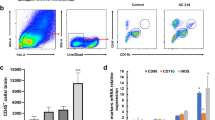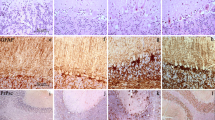Abstract
Recent studies have established the involvement of nasal-associated lymphoid tissues, mainly the pharyngeal tonsil, in prion pathogenesis. However, the mechanisms of the associated neuroinvasion are still debated. To determine potential sites for prion neuroinvasion inside the ovine pharyngeal tonsil, the topography of heavy (200 kDa) and light (70 kDa) neurofilaments and of glial fibrillar acidic protein has been semi-quantitatively analysed inside the various compartments of the tonsil. The results show that the most innervated areas are the interfollicular area and the connective tissue located beneath the respiratory epithelium. The existence of rare synapses between follicular dendritic cells and nerve fibres inside the germinal centre indicates that this mechanism of neuroinvasion is possible but, since germinal centres of lymphoid follicles are poorly innervated, other routes of neuroinvasion are likely. The host PRNP genotype does not influence the pattern of innervation in these various tonsil compartments, unlike ageing during which an increase of nerve endings occurs in a zone of high trafficking cells beneath the respiratory epithelium. A minimal age-related increase of innervation inside the lymphoid follicles has also been observed. An increase in nerve fibre density around the lymphoid follicles, in an area rich in mobile cells such as macrophages and dendritic cells capable of capturing and conveying pathogen prion protein (PrPd), might ensure more efficient infectivity, not in the early phase but in the advanced phase of lymphoinvasion after the amplification of PrPd; alternatively, this area might even act as a direct site of entry during neuroinvasion.






Similar content being viewed by others
References
Andreoletti O, Berthon P, Marc D, Sarradin P, Grosclaude J, Keulen L van, Schelcher F, Elsen JM, Lantier F (2000) Early accumulation of PrP(Sc) in gut-associated lymphoid and nervous tissues of susceptible sheep from a Romanov flock with natural scrapie. J Gen Virol 81:3115–3126
Baylis M, Goldmann W, Houston F, Cairns D, Chong A, Ross A, Smith A, Hunter N, McLean AR (2002) Scrapie epidemic in a fully PrP-genotyped sheep flock. J Gen Virol 83:2907–2914
Baylis M, Chihota C, Stevenson E, Goldmann W, Smith A, Sivam K, Tongue S, Gravenor MB (2004) Risk of scrapie in British sheep of different prion protein genotype. J Gen Virol 85:2735–2740
Bessen RA, Martinka S, Kelly J, Gonzalez D (2009) Role of the lymphoreticular system in prion neuroinvasion from the oral and nasal mucosa. J Virol 83:6435–6445
Bessen RA, Shearin H, Martinka S, Boharski R, Lowe D, Wilham JM, Caughey B, Wiley JA (2010) Prion shedding from olfactory neurons into nasal secretions. PLoS Pathog 6:e1000837
Brown KL, Stewart K, Ritchie DL, Mabbott NA, Williams A, Fraser H, Morrison WI, Bruce ME (1999) Scrapie replication in lymphoid tissues depends on prion protein-expressing follicular dendritic cells. Nat Med 5:1308–1312
Casteleyn C, Van den Broeck W, Simoens P (2007) Histological characteristics and stereological volume assessment of the ovine tonsils. Vet Immunol Immunopathol 120:124–135
Casteleyn C, Cornelissen M, Simoens P, Van den Broeck W (2010) Ultramicroscopic examination of the ovine tonsillar epithelia. Anat Rec (Hoboken) 293:879–889
Cazaubon S, Viegas P, Couraud PO (2007) Functions of prion protein PrPc. Med Sci (Paris) 23:741–745
Ciriaco E, Ricci A, Bronzetti E, Mammola CL, Germana G, Vega JA (1995) Age-related changes of the noradrenergic and acetylcholinesterase reactive nerve fibres innervating the pigeon bursa of Fabricius. Ann Anat 177:237–242
Defaweux V, Dorban G, Antoine N, Piret J, Gabriel A, Jacqmot O, Falisse-Poirier N, Flandroy S, Zorzi D, Heinen E (2007) Neuroimmune connections in jejunal and ileal Peyer’s patches at various bovine ages: potential sites for prion neuroinvasion. Cell Tissue Res 329:35–44
Dorban G, Defaweux V, Demonceau C, Flandroy S, Van Lerberghe PB, Falisse-Poirrier N, Piret J, Heinen E, Antoine N (2007) Interaction between dendritic cells and nerve fibres in lymphoid organs after oral scrapie exposure. Virchows Arch 451:1057–1065
Flechsig E, Weissmann C (2004) The role of PrP in health and disease. Curr Mol Med 4:337–353
Follet J, Lemaire-Vieille C, Blanquet-Grossard F, Podevin-Dimster V, Lehmann S, Chauvin JP, Decavel JP, Varea R, Grassi J, Fontes M, Cesbron JY (2002) PrP expression and replication by Schwann cells: implications in prion spreading. J Virol 76:2434–2439
Glatzel M, Heppner FL, Albers KM, Aguzzi A (2001) Sympathetic innervation of lymphoreticular organs is rate limiting for prion neuroinvasion. Neuron 31:25–34
Gotow T (2000) Neurofilaments in health and disease. Med Electron Microsc 33:173–199
Griffith JS (1967) Self-replication and scrapie. Nature 215:1043–1044
Halliday S, Houston F, Hunter N (2005) Expression of PrPC on cellular components of sheep blood. J Gen Virol 86:1571–1579
Hamir AN, Kunkle RA, Richt JA, Miller JM, Greenlee JJ (2008) Experimental transmission of US scrapie agent by nasal, peritoneal, and conjunctival routes to genetically susceptible sheep. Vet Pathol 45:7–11
Heggebo R, Press CM, Gunnes G, Lie KI, Tranulis MA, Ulvund M, Groschup MH, Landsverk T (2000) Distribution of prion protein in the ileal Peyer’s patch of scrapie-free lambs and lambs naturally and experimentally exposed to the scrapie agent. J Gen Virol 81:2327–2337
Horiuchi M, Yamazaki N, Ikeda T, Ishiguro N, Shinagawa M (1995) A cellular form of prion protein (PrPC) exists in many non-neuronal tissues of sheep. J Gen Virol 76:2583–2587
Hunter N, Goldmann W, Foster JD, Cairns D, Smith G (1997) Natural scrapie and PrP genotype: case-control studies in British sheep. Vet Rec 141:137–140
Hunter N, Foster J, Chong A, McCutcheon S, Parnham D, Eaton S, MacKenzie C, Houston F (2002) Transmission of prion diseases by blood transfusion. J Gen Virol 83:2897–2905
Jeffrey M, Gonzalez L (2007) Scrapie. In: Aitken ID (ed) Diseases of sheep, 4th edn. Blackwell, Edinburgh, pp 242–250
Jeffrey M, McGovern G, Goodsir CM, Brown KL, Bruce ME (2000) Sites of prion protein accumulation in scrapie-infected mouse spleen revealed by immuno-electron microscopy. J Pathol 191:323–332
Jessen KR, Morgan L, Stewart HJ, Mirsky R (1990) Three markers of adult non-myelin-forming Schwann cells, 217c(Ran-1), A5E3 and GFAP: development and regulation by neuron-Schwann cell interactions. Development 109:91–103
Kincaid AE, Bartz JC (2007) The nasal cavity is a route for prion infection in hamsters. J Virol 81:4482–4491
Kraehenbuhl JP, Neutra MR (2000) Epithelial M cells: differentiation and function. Annu Rev Cell Dev Biol 16:301–332
Lee MK, Cleveland DW (1996) Neuronal intermediate filaments. Annu Rev Neurosci 19:187–217
Mabbott NA, Mackay F, Minns F, Bruce ME (2000) Temporary inactivation of follicular dendritic cells delays neuroinvasion of scrapie. Nat Med 6:719–720
Madden KS, Bellinger DL, Felten SY, Snyder E, Maida ME, Felten DL (1997) Alterations in sympathetic innervation of thymus and spleen in aged mice. Mech Ageing Dev 94:165–175
Maignien T, Lasmezas CI, Beringue V, Dormont D, Deslys JP (1999) Pathogenesis of the oral route of infection of mice with scrapie and bovine spongiform encephalopathy agents. J Gen Virol 80:3035–3042
Marruchella G, Ligios C, Baffoni M, Cancedda MG, Demontis F, Donatucci G, Chiocchetti R, Clavenzani P, Lalatta-Costerbosa G, Di Guardo G (2009) Ileal tract and Peyer’s patch innervation in scrapie-free versus scrapie-affected ovines. Arch Virol 154:709–714
Martins VR, Mercadante AF, Cabral AL, Freitas AR, Castro RM (2001) Insights into the physiological function of cellular prion protein. Braz J Med Biol Res 34:585–595
McGovern G, Martin S, Gonzalez L, Witz J, Jeffrey M (2009) Frequency and distribution of nerves in scrapie-affected and unaffected Peyer’s patches and lymph nodes. Vet Pathol 46:233–240
Melot F, Defaweux V, Jolois O, Collard A, Robert B, Heinen E, Antoine N (2004) FDC-B1: a new monoclonal antibody directed against bovine follicular dendritic cells. Vet Immunol Immunopathol 97:1–9
Miller MW, Williams ES, Hobbs NT, Wolfe LL (2004) Environmental sources of prion transmission in mule deer. Emerg Infect Dis 10:1003–1006
Notturno F, Caporale CM, De Lauretis A, Uncini A (2008) Glial fibrillary acidic protein: a marker of axonal Guillain-Barre syndrome and outcome. Muscle Nerve 38:899–903
Prinz M, Heikenwalder M, Junt T, Schwarz P, Glatzel M, Heppner FL, Fu YX, Lipp M, Aguzzi A (2003) Positioning of follicular dendritic cells within the spleen controls prion neuroinvasion. Nature 425:957–962
Prusiner SB (1982) Novel proteinaceous infectious particles cause scrapie. Science 216:136–144
Race R, Jenny A, Sutton D (1998) Scrapie infectivity and proteinase K-resistant prion protein in sheep placenta, brain, spleen, and lymph node: implications for transmission and antemortem diagnosis. J Infect Dis 178:949–953
Sbriccoli M, Cardone F, Valanzano A, Lu M, Graziano S, De Pascalis A, Ingrosso L, Zanusso G, Monaco S, Bentivoglio M, Pocchiari M (2009) Neuroinvasion of the 263K scrapie strain after intranasal administration occurs through olfactory-unrelated pathways. Acta Neuropathol 117:175–184
Seeger H, Heikenwalder M, Zeller N, Kranich J, Schwarz P, Gaspert A, Seifert B, Miele G, Aguzzi A (2005) Coincident scrapie infection and nephritis lead to urinary prion excretion. Science 310:324–326
Van Keulen LJM, Vromans MEW, Van Zijderveld FG (2002) Early and late pathogenesis of natural scrapie infection in sheep. APMIS 110:23–32
Vascellari M, Nonno R, Mutinelli F, Bigolaro M, Di Bari MA, Melchiotti E, Marcon S, D'Agostino C, Vaccari G, Conte M, De Grossi L, Rosone F, Giordani F, Agrimi U (2007) PrPSc in salivary glands of scrapie-affected sheep. J Virol 81:4872–4876
Weissmann C (2004) The state of the prion. Nat Rev Microbiol 2:861–871
Acknowledgements
We acknowledge the technical assistance of Dr. P. Hubert. We thank Professor E. Heinen from the Human Histology Unit of The Faculty of Medicine of the University of Liege who kindly provided the FDC-B1 monoclonal antibody.
Author information
Authors and Affiliations
Corresponding author
Rights and permissions
About this article
Cite this article
Toppets, V., Piret, J., Kirschvink, N. et al. Neuroimmune connections in ovine pharyngeal tonsil: potential site for prion neuroinvasion. Cell Tissue Res 348, 167–176 (2012). https://doi.org/10.1007/s00441-012-1376-x
Received:
Accepted:
Published:
Issue Date:
DOI: https://doi.org/10.1007/s00441-012-1376-x




